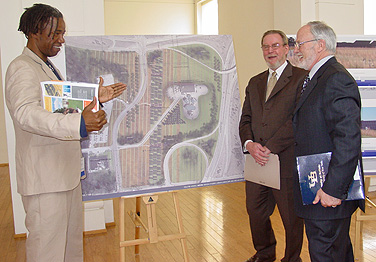
(From left) Walter Hood, campus architect Robert Shibley and President John B. Simpson stand in front of Hood’s winning design, “The Solar Strand,” after a press conference last week to announce Hood as the winning designer. Photo: REANNA KAOPUIKI
Hood, founding principal of Hood Design and professor and former chair of the Landscape Architecture Department at the University of California-Berkeley, calls his concept “The Solar Strand,” which refers to a linear landscape formation and to the way pairs of molecules entwine to form a DNA strand.
When complete, the solar installation’s 5,000 photovoltaic (PV) panels will generate solar energy for 735 student apartments at UB, reducing the university’s carbon emissions by more than 500 metric tons per year. The project will serve as a cornerstone of NYPA’s $21 million statewide renewable energy program.
Funded by a grant of up to $7.5 million from NYPA, it will be the largest solar installation on a college or university campus in New York state and one of the largest on a college or university campus in the country. It also will advance a principal goal of the UB 2020 strategic plan: to improve the environmental sustainability of the university’s three campuses.
UB conducted an invitational design competition to ensure that the solar installation, which will line the Flint Road entrance to the North Campus, will create a visually attractive gateway that integrates beauty with engineering innovation and environmental sustainability.
“The university sees the project as more than an energy-producing facility—we envision this as a significant land art installation that will complement the Buffalo Niagara region’s already significant reputation as a destination for world-class art and architecture,” says President John B. Simpson. The solar installation will be integrated with UB’s academic programming, research initiatives and workforce training efforts focused on sustainability and the green technologies, he adds.
NYPA President Richard Kessel says the project will “demonstrate the potential of solar technology and advance New York state’s efforts to be a leader in sustainable energy and the creation of green jobs.
“The UB solar project will lead to development of other projects throughout the state that will produce considerable cost savings over time,” he notes.
Hood’s design was selected by a panel that was co-chaired by Louis Grachos, director of the Albright-Knox Art Gallery, and Ted Pietrzak, director of the Burchfield Penney Art Center. The competition's two other finalists were Vito Acconci and Diana Balmori.
Other members of the selection panel were Robert Shibley, UB campus architect, professor of architecture and planning, and senior adviser to the president for campus planning and design; Millie Chen, associate professor and chair of the UB Department of Visual Studies; Charles Hermann, research and technology development engineer with NYPA; and Robert Faber, director of special projects with DeCloet Greenhouse Manufacturing Ltd., the project engineer and construction contractor.
Hood’s design for the solar array physically resembles the linear pattern of a DNA fingerprint. “And, like a DNA fingerprint,” Hood says, “solar panels would be codified and arranged to show how much power is captured/generated and where it is used.” The panels are only part of the story, however.
Hood is above all an artist, as well as a landscape architect, and says his design also would reinforce existing freeway/roadway drainage patterns to create a new “patch ecology” that would merge with existing creeks and campus woodlands.
Patch is a term fundamental to landscape ecology. It defines a relatively homogeneous area that differs from its surroundings but has a definite shape and spatial configuration, and can be described compositionally by internal variables, such as the number of trees, number of tree species, height of trees or other similar measurements.
Plantings in and among the solar panels, Hood says, would reinforce and merge with the existing creek and campus wood patch ecology. Oaks, maples, redbuds and ground covers would be planted, along with ornamental species like linden and malus (small deciduous trees or shrubs of the crabapple family) to provide microclimate and display. Hood also would seed and plant low-maintenance grasses like bent grass and red fescue in strands or striations to reinforce the array and recall the site’s agricultural past.
“The landscape development reinforces the campus as a whole,” he says, “by connecting the tree canopy and the larger hydrological morphology.”
Hood also envisions educational and social uses for the solar panel system, primarily through the development of “social rooms” that would break through the PV array at three locations. At each site, retention/detention swales and ponds will create groundwork adjacent to the towering panels, and seating, lighting and other furnishings will facilitate outdoor use.
These recreational/educational spaces would be connected to walks, trails and paths that connect to a visitor center, the campus’ mirrored Chilled Water Facility and parking.
A pioneering urbanist, Hood heads a firm committed to issues that address the re-construction of urban landscapes within towns and cities. His concept for this project demonstrates his attraction to the exploration of ways that landscape typologies reinforce and re-make landscapes specific to place and the people who occupy them.
Hood has made important contributions to the cities of Oakland and San Francisco by refurbishing 10 local parks and tailoring some of them for reuse, and restoring several well-known memorials in San Francisco, among them the Abraham Lincoln Brigade Monument on the Embarcadero and five acres of landscape surrounding the new De Young museum in Golden Gate Park.
No comments:
Post a Comment